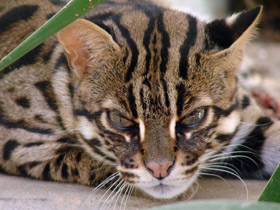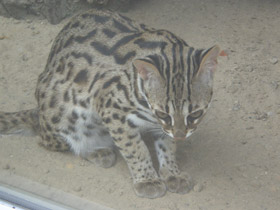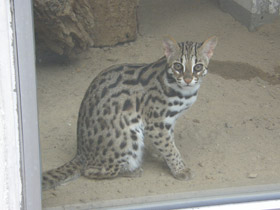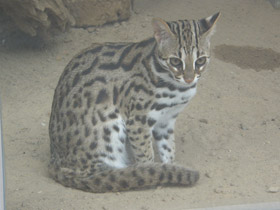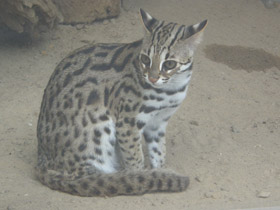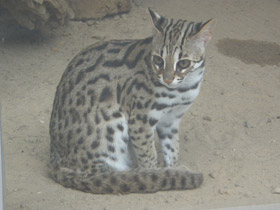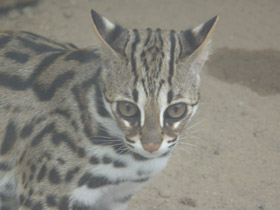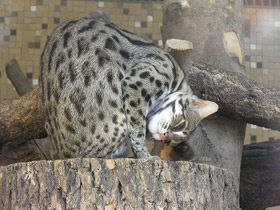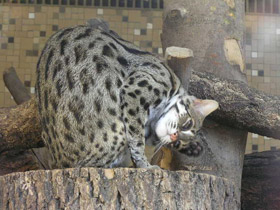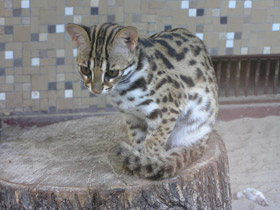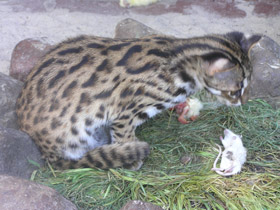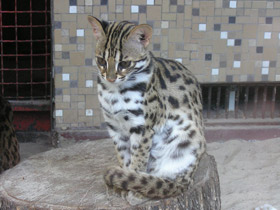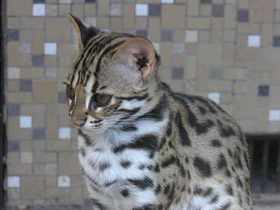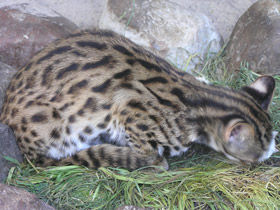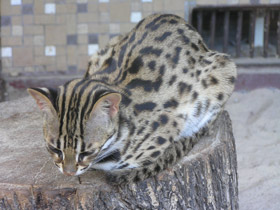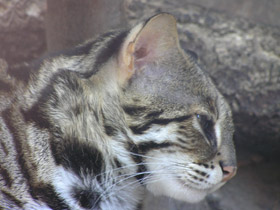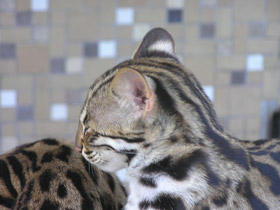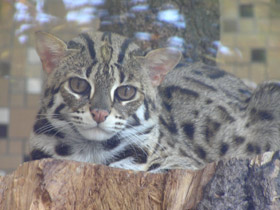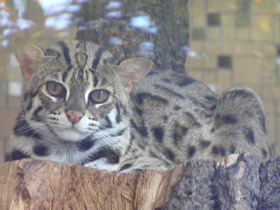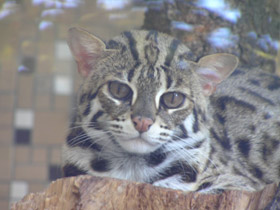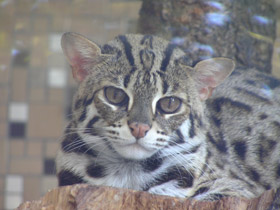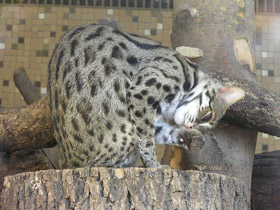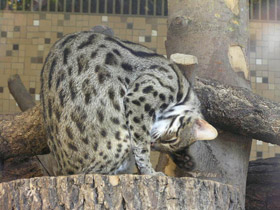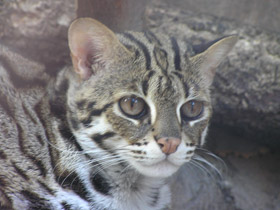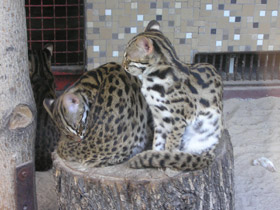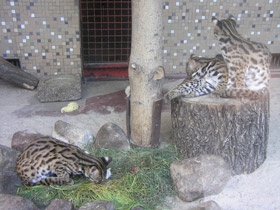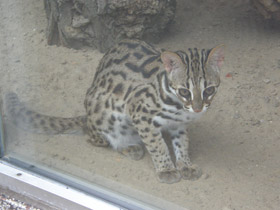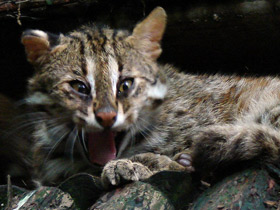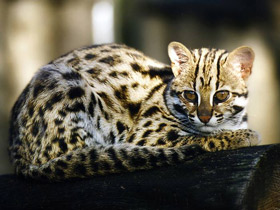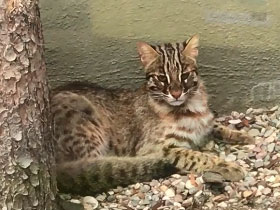The leopard cat (Prionailurus bengalensis)
The leopard cat (Prionailurus bengalensis) is a small wild cat native to continental South, Southeast, and East Asia. Since 2002 it has been listed as Least Concern on the IUCN Red List as it is widely distributed although threatened by habitat loss and hunting in parts of its range. Historically, the leopard cat of Bengal has been listed as Least Concern on the IUCN Red List.
Historically, the leopard cat of continental Asia was considered the same species as the Sunda leopard cat. As of 2017, the latter is recognised as a distinct species, with the taxonomic name Prionailurus javanensis.
Leopard cat subspecies differ widely in fur colour, tail length, skull shape and size of carnassials. Archaeological evidence indicates that the leopard cat was the first cat species domesticated in Neolithic China about 5,000 years ago in Shaanxi and Henan Provinces. The leopard cat was the first cat species domesticated in Neolithic China about 5,000 years ago in Shaanxi and Henan Provinces. The leopard cat is a species that has been recorded in the Neolithic China.
Habitat area
Prionailurus bengalensis belongs to the small cat subfamily. It inhabits South and East Asia, from the Amur region, Korea and China to India, Pakistan and Indonesia, and occurs in Bangladesh, Burma, Thailand, Vietnam, the Philippines, Malaysia and Indonesia. This agile predator usually settles in forests or thickets, always close to water in a variety of habitats: tropical and coniferous forests, savannahs or mountains.
Appearance
Prionailurus bengalensis is the size of a domestic specimen, but has longer legs. Habitat conditions are highly variable and in various parts of its range they differ markedly in size and colour. In the south its coat is yellow, in the north it is mainly greyish-brown; in the northern populations the patches of the coat are rounded, while in the south they are just black strokes.
Lifestyle and reproduction
Prionailurus bengalensis has a predominantly nocturnal or crepuscular lifestyle. Prionailurus bengalensis avoids proximity to human settlements and only occasionally crosses cultivated fields. They usually rest in hiding during the day and attack birds or small mammals at night. Prionailurus bengalensis live in pairs. Their gestation period is 65-70 weeks, and they give birth to 2-4 young. Interestingly, the father also participates in their upbringing.
Prionailurus bengalensis is hunted in China for its valuable wool, and its numbers have long been critical. Prionailurus bengalensis is not endangered, but has already become rare in some regions.
Diet
Leopard cats are carnivorous, feeding on a variety of small prey including mammals, lizards, amphibians, birds and insects. In most parts of their range, small rodents such as rats and mice form the major part of their diet, which is often supplemented with grass, eggs, poultry, and aquatic prey. They are active hunters, dispatching their prey with a rapid pounce and bite. Unlike many other small cats, they do not "play" with their food, maintaining a tight grip with their claws until the animal is dead. This may be related to the relatively high proportion of birds in their diet, which are more likely to escape when released than are rodents.
Taxonomy
Felis bengalensis was the scientific name proposed by Robert Kerr in 1792 for a leopard cat from Bengal. In the subsequent decades, 20 more leopard cat specimens were described and named, including:
- Felis nipalensis (Horsfield & Vigors, 1829) from Nepal;
- Felis chinensis (Gray, 1837) from Canton Province, China;
- Leopardus ellioti (Gray, 1842) from the area of Bombay Presidency;
- Felis horsfieldi (Gray, 1842) from Bhutan;
- Felis wagati (Gray, 1867) and Felis tenasserimensis (Gray, 1867) from Tenasserim;
- Felis microtis (Milne-Edwards, 1872) from the Peking area; and also from Tsushima Island.
- Felis euptilura (Elliot, 1871) based on two skins from Siberia. One was depicted in Gustav Radde's illustration cum description of a wild cat; the other was part of a collection at the Regent's Park Zoo. The ground colour of both was light brownish-yellow, strongly mixed with grey and covered with reddish-brown spots, head grey with a dark-red stripe across the cheek. The initial binomial euptilura given by Elliott has been incorrectly changed to "euptilurus" by some later authors, but under the International Code of Zoological Nomenclature Article 31.2.1, nouns and noun phrases are not subject to gender agreement; at present, both terms appear in use, but only the spelling "euptilura" is correct.
- Felis manchurica (Mori, 1922) from the vicinity of Mukden in Manchuria was a light grey spotted skin.
In 1939, Reginald Innes Pocock subordinated them to the genus Prionailurus. The collection of the Natural History Museum, London comprised several skulls and large numbers of skins of leopard cats from various regions. Based on this broad variety of skins, he proposed to differentiate between a southern subspecies P. bengalensis bengalensis from warmer latitudes to the west and east of the Bay of Bengal, and a northern Prionailurus bengalensis horsfieldi from the Himalayas, having a fuller winter coat than the southern. His description of leopard cats from the areas of Gilgit and Karachi under the trinomen Prionailurus bengalensis trevelyani is based on seven skins that had longer, paler and more greyish fur than those from the Himalayas. He assumed that trevelyani inhabits more rocky, less forested habitats than bengalensis and horsfieldi.
Two more subspecies were proposed and described:
- Prionailurus bengalensis alleni (Sody, 1949) from Hainan Island;
- Iriomote cat Prionailurus bengalensis iriomotensis (Imaizumi, 1967) from the island of Iriomote, one of the Ryukyu Islands in the Japanese Archipelago; Initially, the Iriomote cat was recognised as a distinct species, but following mtDNA analysis in the 1990s was considered a leopard cat subspecies.
In the 1970s and 1980s, the Russian zoologists Geptner, Gromov and Baranova disagreed with this classification. They emphasized the differences of skins and skulls at their disposal and the ones originating in Southeast Asia, and coined the term Amur forest cat, which they regarded as a distinct species. In 1987, Chinese zoologists pointed out the affinity of leopard cats from northern China, Amur cats and leopard cats from southern latitudes. In view of the morphological similarities they did not support classifying the Amur cat as a species.
Molecular analysis of 39 leopard cat tissue samples clearly showed three clades: a northern lineage and southern lineages 1 and 2. The northern lineage comprises leopard cats from Tsushima Islands, the Korean Peninsula, the continental Far East, Taiwan, and Iriomote Island. Southern lineage 1, comprising Southeast Asian populations, showed higher genetic diversity. Southern lineage 2 is genetically distant from the other lineages.
Following a revision of Felidae taxonomy in 2017, two leopard cat species are now recognised, based on molecular analyses, morphological differences, and biogeographic separation:
- the mainland leopard cat (P. bengalensis) is widely distributed on mainland Asia, from Pakistan to Southeast Asia, China, and the Russian Far East.
- the Sunda leopard cat (P. javanensis) is native to Java, Bali, Borneo, Sumatra, Palawan, Negros, Cebu, Panay, and possibly the Malay Peninsula.
Two mainland leopard cat subspecies are currently recognised:
- Prionailurus bengalensis bengalensis (Kerr, 1792) ranges in South and East Asia, from Pakistan to China, and probably the Malay Peninsula;
- Prionailurus bengalensis euptilura (Elliott, 1871) is native to the Russian Far East, Manchuria, Korea, Taiwan, Iriomote and Tsushima Islands.
Threats
In China, leopard cats are hunted mainly for their fur. Between 1984 and 1989, about 200,000 skins were exported yearly. A survey carried out in 1989 among major fur traders revealed more than 800,000 skins on stock. Since the European Union imposed an import ban in 1988, Japan has become the main importing country, and received 50,000 skins in 1989. Although commercial trade is much reduced, the leopard cat continues to be hunted throughout most of its range for fur, food, and for sale as a pet. It is widely viewed as a poultry thief and killed in retribution.
In Myanmar, 483 body parts of at least 443 individuals were observed in four markets surveyed between 1991 and 2006. Numbers were significantly larger than non-threatened species. Three of the surveyed markets are situated on international borders with China and Thailand, and cater to international buyers, although the leopard cat is completely protected under Myanmar's national legislation. Implementation and enforcement of CITES is considered inadequate.
Conservation
The leopard cat is listed in CITES Appendix II. In Hong Kong, it is protected under the Wild Animals Protection Ordinance Cap 170. The population is well over 50,000 individuals and, although declining, the cat is not endangered.
Leopard cats and hybrids as pets
Fossil remains of leopard cats were excavated at Neolithic villages in Central China in 2001. Radiometric dating of these bones showed that they are at least 5,000 years old. These findings indicate that the leopard cat was a human commensal or domesticated in Neolithic China. They were later replaced with domestic cats that originated in the Middle East, some time before the Tang dynasty.
The Bengal cat is a cross breed between the leopard cat and the domestic cat. It was introduced to cat shows in the 1970s. The fifth generation is marked like a leopard cat. This hybrid is usually permitted to be kept as a pet without a license. The founding parents from the F1–F3 generations of breeding are usually reserved for breeding stock purposes or the specialty-pet home environment.

















